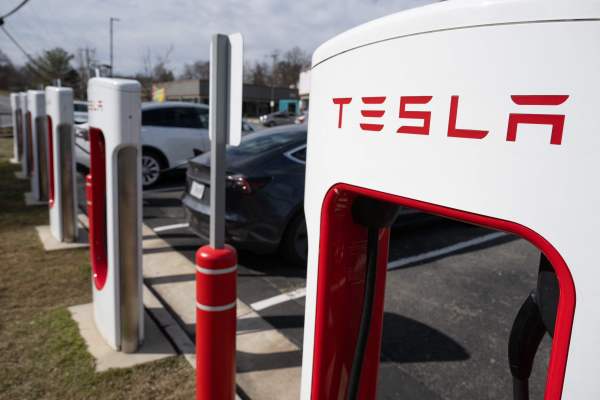If Tesla wants to maintain its Supercharger network’s reputation, it’s got some work to do.
The automaker has recently agreed to open a large portion of its chargers to Ford and GM starting next year. The move promises to bolster Tesla’s bottom line as it begins to monetize a costly capital investment, but it also risks upsetting existing and future owners, who will soon have to contend with more competition for charging space.
Currently, Tesla drivers can charge at the largest and most well-distributed network in the U.S that utilizes some of the sleekest hardware and technology. Given Tesla’s total fleet size in the U.S., there are only about 80 cars competing for any given charging stall. That low number has meant that wait times are usually minimal to nonexistent. (Holidays and weekends at high-traffic locations are exceptions, of course.) Tesla’s vehicle-charger ratio is more than twice as good as its competitors combined.
But the Ford and GM deals throw those numbers into doubt by opening more than 12,000 Supercharger stalls out of the 19,210 that Tesla has installed to date. Both GM and Ford have a large number of EVs on the road today — about 120,000 and 90,000, respectively — and they have plans to ramp up North American production significantly.
Tesla owners will likely begin to feel some pain next year. Given GM and Ford’s production targets, it’s likely that the two automakers will put nearly a quarter million more EVs on the road this year and nearly three-quarters of a million next year. By 2025, they could potentially be selling a combined 1.5 million EVs annually. That would bring their combined EV fleet to somewhere between 2.5 million to 3 million vehicles by 2025.
By comparison, Tesla’s U.S. fleet will likely grow to somewhere between 3 million to 3.5 million by 2025, based on past sales and future production capacity. Around three years from now, just over 6 million vehicles will be eligible to juice up at Superchargers. Only about 1.7 million are today.
Now, Tesla hasn’t promised to open every Supercharger to Ford and GM, just a portion. It’s possible the trio will revise their deal to add more stalls, but let’s assume for now that the number will remain fixed over the next few years. Even still, Tesla will have to build somewhere around 45,000 to 50,000 new Supercharger stalls in the next two-plus years to maintain the vehicle-to-stall ratio that Tesla owners enjoy today.
The number that Tesla actually needs to build might be somewhat lower. There are plenty of remote locations that won’t need to double their capacity. By analyzing network usage, sales figures and vehicle travel patterns, the company should be able to trim that figure significantly.
Still, it’s likely that Tesla will need to nearly double its U.S. Supercharger network in a little over two years. That’ll require significant capital investment into a business line that is likely a drag on profit margins. If Tesla charges exorbitantly high rates to maintain margins, consumers may prove to be as price sensitive to fast-charging prices as they are to gas prices. To save a few bucks, Ford and GM drivers might be willing to take their chances on a cheaper network with a longer wait time. (To wit: Costco gas lines.)
Today, the Supercharger network is one of Tesla’s greatest selling points. It’s fast, reliable and dead simple to use. In the coming years, though, demand will skyrocket as will wear and tear. Not only will the Ford and GM deals test the network, Tesla’s own sales goals will, too.
In the coming years, Tesla will face a difficult choice: spend big to maintain the Supercharger network’s high level of service or “optimize” the network for higher revenue at the expense of availability. Ultimately, the drag of operating an expansive, open network of EV chargers could be too much for shareholders to bear and pressure might build for Tesla to spin it off. If that happens, the financial pressures on the Supercharger network will begin to resemble those of competitors, and that won’t be a good thing for anyone.
